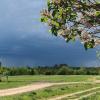
The global human population is growing and at 7.7 billion, there are currently more humans walking the Earth than ever before. Simultaneously, but far less conspicuously, rural populations have plummeted by nearly a quarter in the last 50 years.
This has left behind abandoned agricultural land with unknown consequences for ecosystems and biodiversity. Following abandonment, it is possible that land returns to its previous natural state and thus contributes to conservation. Another likely alternative is the emergence of novel ecosystems without historical analogue which might be detrimental for both biodiversity and humanity. In direct answer to the pressing problem of unknown conservation value of abandoned land, I am conducting data syntheses as well as place-based field research, bridging the disciplines of ecology, remote sensing and human demography to reveal the ecological impacts of land abandonment. The findings of my research have the potential to chart a new direction for conservation and restoration across the Anthropocene.
Biodiversity is changing across the planet. The rising concern for the state of the planet has culminated in the first Global Biodiversity Assessment by the Intergovernmental Science-Policy Platform on Biodiversity and Ecosystem Services published in 2020. The Global Biodiversity Assessment and the forthcoming signing of the new Convention on Biological Diversity in 2021 have set biodiversity change on the agenda for country leaders globally, yet we are missing key evidence regarding the conservation role of the increasingly abundant abandoned land. If biodiversity and particularly species providing key services to humanity increase following abandonment, abandoned land can become the next frontline for conservation feeding into the international goal of protecting 30% of the planet by 2030. On the contrary, if abandoned land turns into a biodiversity sink dominated by wide-spread invasive species, we might be underestimating the long-term impacts of agriculture, and future restoration should target abandoned areas to avoid further ecological degradation. During my Schmidt Science Fellowship, I am quantifying the ecological fingerprint of land abandonment and accelerate the management and conservation of the planet.
